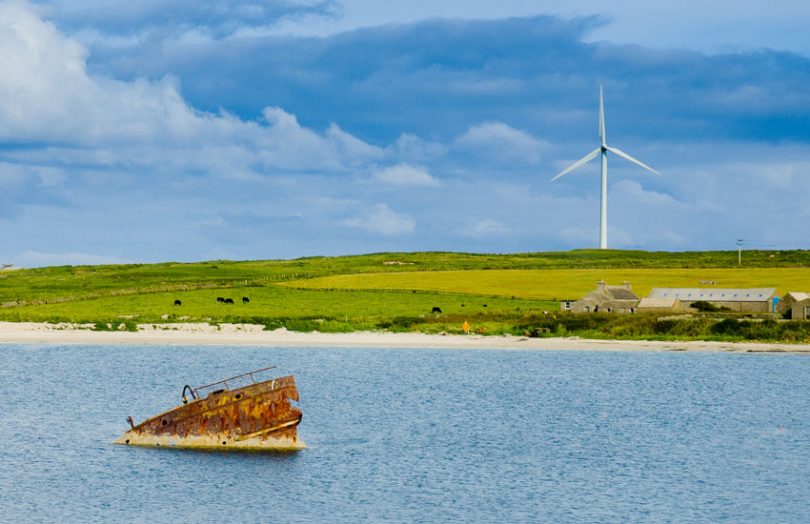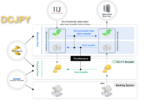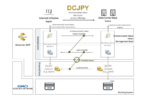Local energy trading using blockchain is now live in the Orkney islands off the coast of Scotland. The project is led by UK entech company Electron. Over 1,100 trades have taken place at the time of writing since the end of March.
Project TraDER supported by the UK Department for Business, Energy & Industrial Strategy (BEIS) aims to deliver a marketplace for multiple energy services in the renewable sector.
The challenge for networks with variable weather and time dependent renewables is to match the supply and demand. Windswept Orkney is an apt location to trial the technology, having a high level of renewable generation that frequently exceeds demand and consequently is lost when generators are switched off or curtailed. TraDER provides the market layer to bring together the generators and local storage assets to reduce those levels of curtailment while also ensuring the network remains stable. Such assets include storage batteries and electric vehicles, which can both store and release energy.
“We want to make it easier for distributed energy resources (DERs) to play their full role in lowering the cost and carbon intensity of managing the grid,” says Jo-Jo Hubbard, CEO of Electron. “We believe that this is the first multi-sided local marketplace that actually affects the physical flow of power and brings more zero carbon, zero marginal cost power online.”
The eight-member project consortium includes electricity utilities EDF and Scottish and Southern Electricity Networks, industry and research partners and the NGO Community Energy Scotland.
Blockchain platform
Electron is a leading pioneer of blockchain in the energy sector. The company’s first project was the implementation of a blockchain-based asset register and supplier switching solution. Other projects have focused on energy management and trading in different energy markets.
Electron’s project approach is characterized by the build of a consortium of partners, who contribute industry expertise and ultimately will be the drivers of the technology.
Hubbard says that Electron’s core platform can be thought of as a decentralized micro-services architecture that enables many different parties to host data sets and stand-up markets and/or services across a shared set of functions and rules.
“The Orkney renewables curtailment market is an example of one type of market that can be hosted on this infrastructure. This one happens to be operated by Electron, but the platform is designed such that this is not necessary.”
In terms of implementation, it’s a matter of connecting an API (application programming interface). “This means that we can interact with many different types of connected asset as long as they are controlled. Integration with these internet of things (IoT) systems only requires communication through our available APIs and enrollment on the blockchain-based asset register,” said Hubbard.
The workflow is that renewable generators, in this case wind, submit the price they would be willing to pay a local storage asset to avoid being curtailed. This can be done in advance. Then, in real time when the curtailment signal is received, the price and required asset volume go live, at which point it is matched with the available storage assets.
As the project evolves, the aim is to continue to expand through integration with the active network management system to bring more parties online, with the goal to aggregate local and ultimately national markets.
Trading and transacting
Orkney, along with other Scottish islands, has long been at the forefront of the clean energy movement in a bid to become more self-sustaining and has been involved in several energy projects. Issues these have addressed include the development of digital solutions for island grids and the integration of local heating networks, electric vehicles and the electricity grid into a single controllable system. TraDER builds on both these foundational developments as well as those by Electron in its earlier projects.
Renewables trading has become one of the most popular use cases for blockchain in the energy sector. This is partly a reflection of its importance for future energy systems. As the penetration of DERs grows, so will the need to track an ever-growing number of transactions between connected devices on a near real time basis.
“Blockchain has a lot of potential for renewable energy trading when it is combined with DERs and IoT devices;” says policy specialist Irene Adamski, co-chair of the Energy working group of the International Association of Trusted Blockchain Applications (INATBA) and former regulatory affairs associate at the Energy Web Foundation.
“With second generation distributed ledger technology and beyond, we are able to automate the necessary optimization operations, while ensuring the veracity of the data due to the immutability aspect of the ledger.”
Other pioneers in this field include LO3 Energy, which has launched projects locally in the US as well as in Europe and Japan, among other locations. Australia’s Power Ledger is another with a growing portfolio of projects across the globe from Australia to India to France. Renewable trading is also one of the key use cases under development by the Energy Web Foundation which was involved in another wind energy storage project.
INATBA’s energy working group is in the early stages of setting up a collaboration framework on energy trading with the University College London Energy Institute and UCL-led Global Observatory on Peer-to-Peer, Community Self-Consumption and Transactive Energy Models.
Commenting on the Orkney project specifically, Adamski says that it is very promising, with the right consortium and a sophistication that could put the UK energy sector ahead of the curve towards the energy transition. However, she cautions the need not to get too far ahead as the project is tailored to its unique island situation.
“Implementing similar solutions for the mainland or a majority of the UK grid will take much more hands-on research, refinement of existing solutions and likely require an eventual hardware rollout for some regions. It will be interesting to see how the next stages of the project will carry out. The data regarding scalability, efficiency gains for the grid and economic viability will be of great interest to the global energy community.”
Adamski adds that blockchain in the energy sector is lucky to have a large number of successful proofs of concept and MVPs. “However, what we need now are mature solutions, able to both scale and integrate with the actual grid without needing huge concessions from regulators and policy makers – something the Orkney project has obviously been able to accomplish.”






